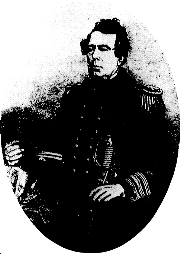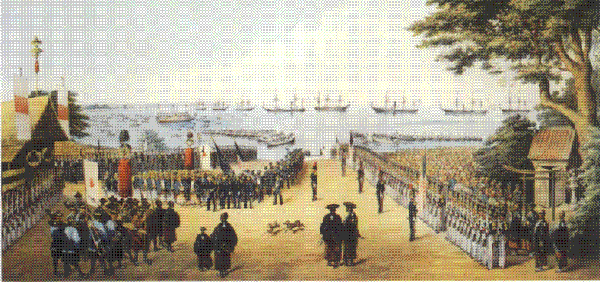- Top page
- Language
- For International Affairs(海外向け)
- Port of Yokohama
- About us
- History of the Port of Yokohama
- The Opening of the Port: East Meets West
Main content starts here.
The Opening of the Port: East Meets West
Last updated date:2024/7/31
![]() The History of the Port of Yokohama
The History of the Port of Yokohama![]() 1) The Opening of the Port:West Meets East
1) The Opening of the Port:West Meets East![]() 2) The Birth of Yokohama City and the Great Kanto Earthquake
2) The Birth of Yokohama City and the Great Kanto Earthquake![]() 3) Earthquake Recovery-World War 2
3) Earthquake Recovery-World War 2![]() 4) Post-war-Rapid Economic Growth
4) Post-war-Rapid Economic Growth![]() 5) The Container Age to Present Day
5) The Container Age to Present Day
On July 7, 1853, Commander Perry, and his four black ships, landed in Uraga and forcefully demanded that Japan end its national isolation policy and open its ports.

Commodore Matthew Calbraith Perry(Collection of YOKOHAMA ARCHIVES OF HISTORY)
The Beginning of International Trade...
Up until that point, only a small handful of countries, like the Netherlands, had a history of trade with Japan. However, this changed in March of 1854 when the Bakufu (the Japanese ruling party of the time) signed the Japan-America Peace, Amity, and Commerce Treaty (a.k.a. the Kanagawa Treaty) and the Harris Treaty (July 1858). As a result, communication began between Japan and the Netherlands, Russia, England, and France.

(Collection of YOKOHAMA ARCHIVES OF HISTORY)
In the year following the Harris Treaty (07/01/1859) foreign countries also received permission to carry out trade between the newly opened ports of Kanagawa, Nagasaki and Hakodate. Originally, the American Consul General Harris did not desire to put Kanagawa or Yokohama on the list of designated ports. The Bakufu government, countered by pointing out that the land within the treaty should contain the area/bay closest to Edo (the former name of Tokyo), because it would become the principal center of foreign trade. Also, the Bakufu desired to keep Japanese and foreigners at a distance in order to avoid communication between the two. Considering the advice of the Japanese ruling party Harris made the recommended to open the Kanagawa area or somewhere near the present day Kanagawa city (of East Kanagawa) and the Japanese government agreed.

(Collection of YOKOHAMA ARCHIVES OF HISTORY)
At that time, Yokohama, being a rural, fishing village, had hardly any poor institutions. After the opening, 2 wharfs were built in place of the present day Osanbashi. Since the wharf was too shallow to all ships to dock, a barge was used to transport freight and passengers from the steam/sailing ships to the dock.
Typical imports of this era:

Cotton Fabrics/Textiles
Typical exports of this era:

Raw Silk

Tea
Page ID:190-238-473

